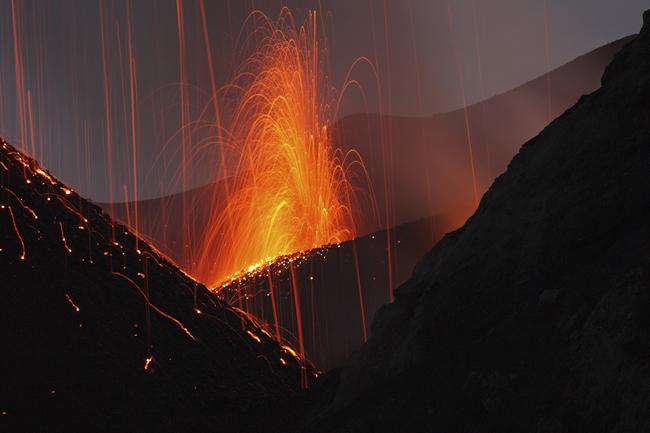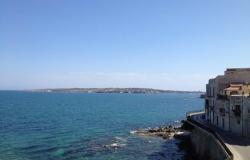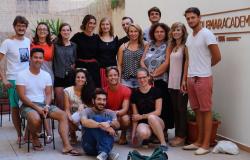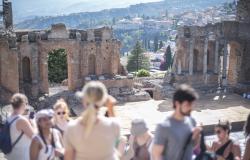[Image: Stromboli erupting.]
Words by Andrew and Suzanne Edwards
In 1950, the film Stromboli was released. Directed by Roberto Rossellini and starring Ingrid Bergman, it's considered a classic of post-war Italian cinema, although the reception at the time was more muted than its current status would suggest. It was Bergman who suggested the couple work together and therein lies the other tale that bubbled under the surface of this cinematic landscape, waiting to erupt.
Needless to say, as the title indicates, Stromboli was set on the Sicilian island of the same name. Ingrid Bergman is the central character, Karin, a Lithuanian who married an Italian POW in the aftermath of the Second World War, hoping for a better future on her husband's volcanic island home. In the tradition of neo-realist cinema, the gritty reality of life intrudes on her hopes and she longs to escape. During the filming, Bergman and her director had an affair which led to their eventual marriage.
At the time, Rossellini was in a relationship with Anna Magnani, whom he had met during the filming of the remarkable Roma, Città Aperta in 1945. Their relationship was somewhat rocky, with outbursts of jealousy and volatility. When the screenplay for Stromboli was ready, Magnani was expecting to take the lead role, only to be spurned for the Swedish actress. Few people would have had the power to get themselves a role in another movie with a similar theme, let alone one that was filmed in another volcanic location in the same Aeolian Island group.

[Ingrid Bergman and Mario Vitale in 'Stromboli'.]
As Magnani was filming Vulcano in that very location, just a few kilometres away Rossellini was directing Stromboli. The tension and rivalry were palpable; you were either in one camp or the other, there was no straddling the fence. Film fanatics in Rome even divided themselves into Bergman and Magnani factions. The critical test of time has definitely favoured Anna's rival and Vulcano has largely been forgotten; its footnote in the annals of film history, the bitterness that prompted its creation.
What of the two islands today? We went in search of the films' traces and life on these two iconic Aeolian rocks. Stromboli is still very active, so much so it has lost much of its population - few people wanting to live under the constant threat of eruption. We approached from the sea, coming from the floral paradise of the wealthier Panarea. Steam rises from the lively cone which dominates the island. If this weren't enough to demonstrate the power of nature, the visitor is confronted by a tsunami warning sign as soon as the boat docks on the north-eastern coast. The two villages of San Vincenzo and San Bartolo lie at the foot of the ascent. The more intrepid can buy or rent climbing gear and then join an organised trip to the furthest point possible.

In the film, the local priest tells Karin of the trouble her husband has taken in finding a job as crew on a local fishing boat. Such opportunities are even scarcer today and much of the remaining populace lives from the curious tourist. As we strolled the tiny streets zig-zagging the hillside, it was difficult to avoid a vague sense of melancholy, particularly as we walked out to the old cemetery from a path behind Piazza San Vincenzo and saw the ramshackle graves that, no doubt, had been moved by volcanic activity. The atmosphere was completed by the deep rumbling sighs from the ogre above. When this happens, the locals, in dialect, say that 'Iddu parla' (He speaks).
The path up through to the graveyard cuts through the wild grasses and winds through the gnarled volcanic rock. When talking to the priest in the film, Bergman's Karin refers to the 'horrible rocks, the desolation, the terror', at which point she stares up towards the summit. It may be a tourist's view, but we found a stark beauty in the landscape, a rawness that is only enhanced by the Mediterranean light chiseling the basalt into sharp relief.
Back in town, Stromboli posters appear everywhere. The red nightmare of fire and lava, the black strident typeface and Bergman's features keep the film's memory alive for every visitor. Postcards show stills in black and white, matching the grainy beach sand washed by the Tyrrhenian surf. As the day slips into night, the island really puts on a show of its own. We joined many others circling the base of the cone in everything from rowing boats to floating gin palaces, all of us awaiting the crepuscular fireworks. Stromboli didn't disappoint. At first, small sparks rose from the crater, to be followed by tongues of orange licking the night sky. Camera flashes echoed every exhalation as 'He' finally gave vent to his true feelings.

Vulcano, the location for Magnani's eponymously titled movie, directed by William Dieterle, has a different feel. Its tectonic activity is less aggressive, with its last eruption dating back to 1888. Time has faded the impact, a metaphor for the declining fortunes of Dieterle's work. Perhaps the film is best remembered, apart from the conflicts, for its innovative use of new underwater cinematography. The techniques used were proposed by Renzo Avanza and four Sicilian friends. It was even Avanza, Rossellini's cousin, who suggested the setting and basic outline for the screenplay. Not only did Roberto press ahead without Magnani, he also left his cousin to pick up the pieces with Dieterle's alternative take.
Magnani plays a prostitute sent back to the island of her birth. Shunned by the neighbours, she does her best to defend her younger sister from the dubious attentions of a local fisherman, who has designs on recruiting her sibling to a life she knows only too well. Apparently, Anna asked for a significant sum to play the lead role. There is no doubt she fills the screen with her personality and great acting talent. Critics, though, still highlight the melodrama that was absent from Rossellini's finished product; Vulcano's more histrionic approach to the story detracted from any possible status as a neo-realist classic. Although, it could be argued that the actual filming went far more smoothly.

[Anna Magnani in 'Vulcano'.]
Despite certain sojourns to other locations, and some reports of filming on the island of Salina, Vulcano captures its Aeolian backdrop well; crests and craters dot the skyline. The island itself is known for various sulphur deposits and it's worth climbing one of the cones, among whose number are the Gran Cratere at 391 metres and the mini Vulcanello, connected by an isthmus to the larger land mass. We decided to follow in the footsteps of the 19th century French writer Guy de Maupassant, and explore the island.
Maupassant had to skirt the dwelling of the British entrepreneur James Stevenson, who had bought a northern portion of land from the Bourbon monarchs. It was the 1888 eruption that persuaded the family that Scotland was a safer region to inhabit. He was in situ for the mineral wealth and Malmsey wine the island could provide. We found no such colonial presence, but couldn't help noticing the rock and its vivid coloration. We'll leave it to Guy to describe the impact it has on the eyes: 'As in Switzerland we sometimes see a stream falling from the top of a mountain, so here we find an unruffled cascade of sulphur that has poured through the crevices. They are fairy-like streams of congealed light, the fluid rays of the sun'.

As we can see from Maupassant's poetic reaction, and the endings of the two movies (we won't spoil them for you), the volcanoes are the real stars of the show. They represent the never-ending force of nature, the fight that humans have to undertake to cling on to these islands of fire and sulphur in the middle of the Mediterranean. This is also the conclusion reached by Francesco Patierno's wonderful documentary, La guerra dei vulcani (The War of the Volcanoes). For those who want to know more about the passionate, complicated and molten menage between the two stars and the director, we can do no better than recommend an hour well-spent watching the reportage and a weekend spent following in their footsteps.
Below is the trailer for "The War of the Volcanoes":








